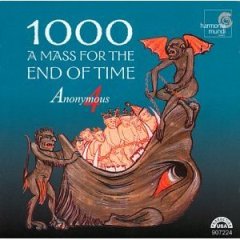1000 - A Mass for the End of Time (2000)
1000 - A Mass for the End of Time (2000)

1. Processional Hymn: Judicii signum 6:13
2. Troped Introit: Quem creditis super astra/Viri galilei10:03
3. Kyrie: Celestis terrestrisque 5:34
4. Gloria: Prudentia prudentium 6:05
5. Alleluia I: Dominus in sina 3:25
6. Alleluia II: Ascendens cristus 4:56
7. Sequence with Prose: Salvator mundi/Rex omnipotens die hodierna 8:15
8. Troped Offertory: Elevatus est rex fortis/Viri galilei 8:29
9. Sanctus: Ante secula 2:50
10. Agnus Dei: Omnipotens eterne 3:03
11. Troped Communion: Corpus quod nunc/Psallite domino 2:34
12. Lection: Apocalypse 21:1-5 2:41
13. Prose: Regnantem sempiterna 2:37
14. Hymn: Cives celestis patrie 5:39
Anonymous 4 (Vocal Ensemble)
Remember all of the year-2000 nervousness in the latter part of 1999? That was nothing. As the year 1000 approached, people all over the Christian world were convinced that the Apocalypse--as depicted in the biblical Book of Revelation--and the end of the world were at hand. In one of the more interesting musical program ideas to be inspired by the turn of the calendrical odometer, Anonymous 4 revisits the original "millennium madness" with a disc of chant from around the year 1000--specifically, a Mass for the Feast of the Ascension, one of the few occasions on which the liturgy included readings from the Book of Revelation. This is the oldest written Western music to have survived, and it's difficult even to decipher (the original notation has no staff lines or clear indications of rhythm), let alone perform. Yet, the challenges involved seem to have done these ladies good: not only is their performance both assured and confident, but one can hear new facets in their vocal sound--a sound that, however beautiful it might be, some listeners find monotonous. (One new facet is Jacqueline Horner, the quartet's newest member, for whom this is the first recording.) The singers experiment with interpretation of ornaments that are indicated in the manuscript sources (there's a fascinating little trill that sounds rather like a cooing dove); in some of the chants, they add an additional line in accordance with the principles of improvising polyphony that were laid out in 10th- and 11th-century treatises. The entire program seems thoroughly considered, as well as immaculately executed. If you count on the consistently pure, silky tone and meditative quality that has made Anonymous 4 world-famous, you'll definitely find it here; if you've gotten bored with them, you might find this disc a fascinating surprise. --Matthew Westphal, amazon.com
download: uploaded yandex 4shared mediafire solidfiles mega filecloudio nornar
Last Updated (Monday, 17 February 2014 17:46)
